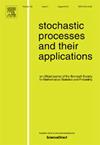Stationary entrance chains and applications to random walks
IF 1.2
2区 数学
Q3 STATISTICS & PROBABILITY
引用次数: 0
Abstract
For a Markov chain with values in a Polish space, consider the entrance chain obtained by sampling at the moments when it enters a fixed set from its complement . Similarly, consider the exit chain, obtained by sampling at the exit times from to . We use the method of inducing from ergodic theory to study invariant measures of these two types of Markov chains in the case when the initial chain has a known invariant measure. We give explicit formulas for invariant measures of the entrance and exit chains under certain recurrence-type assumptions on and , which apply even for transient chains. Then we study uniqueness and ergodicity of these invariant measures assuming that is topologically recurrent, topologically irreducible, and weak Feller.
We give applications to random walks in , which we regard as “stationary” Markov chains started under the Lebesgue measure. We are mostly interested in dimension one, where we study the Markov chain of overshoots above the zero level of a random walk that oscillates between and . We show that this chain is ergodic, and use this result to prove a central limit theorem for the number of level crossings of a random walk with zero mean and finite variance of increments.
固定入口链及其在随机行走中的应用
为马尔可夫链在波兰空间Y值,考虑入口处链通过抽样Y的时刻当它进入一组固定的补充交流。同样,考虑退出链,通过抽样Y在出口处乘以从Ac我们使用诱导的方法遍历理论不变测度的研究这两种类型的马尔可夫链在当初始链Y不变测度。在A和Ac条件下,给出了入口链和出口链在某些递归型假设下的不变测度的显式公式,该公式甚至适用于瞬态链。然后我们研究了这些不变测度的唯一性和遍历性,假设Y是拓扑递归的、拓扑不可约的和弱费勒的。我们给出了Rd中随机游走的应用,我们将其视为在勒贝格测度下开始的“平稳”马尔可夫链。我们最感兴趣的是维一,在这里我们研究在-∞和+∞之间振荡的随机游走的零水平以上的超调的马尔可夫链。我们证明了这条链是遍历的,并利用这一结果证明了零均值和有限方差的随机行走的水平交叉点数量的中心极限定理。
本文章由计算机程序翻译,如有差异,请以英文原文为准。
求助全文
约1分钟内获得全文
求助全文
来源期刊

Stochastic Processes and their Applications
数学-统计学与概率论
CiteScore
2.90
自引率
7.10%
发文量
180
审稿时长
23.6 weeks
期刊介绍:
Stochastic Processes and their Applications publishes papers on the theory and applications of stochastic processes. It is concerned with concepts and techniques, and is oriented towards a broad spectrum of mathematical, scientific and engineering interests.
Characterization, structural properties, inference and control of stochastic processes are covered. The journal is exacting and scholarly in its standards. Every effort is made to promote innovation, vitality, and communication between disciplines. All papers are refereed.
 求助内容:
求助内容: 应助结果提醒方式:
应助结果提醒方式:


